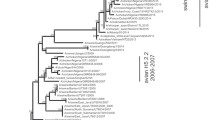Abstract
The majority of the Egyptian swine population was culled in the aftermath of the 2009 H1N1 pandemic, but small-scale growing remains. We sampled pigs from piggeries and an abattoir in Cairo. We found virological evidence of infection with avian H9N2 and H5N1 viruses as well as human pandemic H1N1 influenza virus. Serological evidence suggested previous exposure to avian H5N1 and H9N2, human pandemic H1N1, and swine avian-like and human-like viruses. This raises concern about potential reassortment of influenza viruses in pigs and highlights the need for better control and prevention of influenza virus infection in pigs.



Similar content being viewed by others
References
Abdelwhab EM, Abdel-Moneim AS (2015) Epidemiology, ecology and gene pool of influenza A virus in Egypt: will Egypt be the epicentre of the next influenza pandemic? Virulence 6:6–18
El-Sayed A, Awad W, Fayed A, Hamann HP, Zschock M (2010) Avian influenza prevalence in pigs, Egypt. Emerg Infect Dis 16:726–727
El-Shesheny R, Kandeil A, Bagato O, Maatouq AM, Moatasim Y, Rubrum A, Song MS, Webby RJ, Ali MA, Kayali G (2014) Molecular characterization of avian influenza H5N1 virus in Egypt and the emergence of a novel endemic subclade. J Gen Virol 95:1444–1463
Fuller TL, Gilbert M, Martin V, Cappelle J, Hosseini P, Njabo KY, Aziz SA, Xiao X, Daszak P, Smith TB (2013) Predicting hotspots for influenza virus reassortment. Emerg Infect Dis 19:581–588
Garten RJ, Davis CT, Russell CA, Shu B, Lindstrom S, Balish A, Sessions WM, Xu X, Skepner E, Deyde V, Okomo-Adhiambo M, Gubareva L, Barnes J, Smith CB, Emery SL, Hillman MJ, Rivailler P, Smagala J, de Graaf M, Burke DF, Fouchier RA, Pappas C, Alpuche-Aranda CM, Lopez-Gatell H, Olivera H, Lopez I, Myers CA, Faix D, Blair PJ, Yu C, Keene KM, Dotson PD Jr, Boxrud D, Sambol AR, Abid SH, St George K, Bannerman T, Moore AL, Stringer DJ, Blevins P, Demmler-Harrison GJ, Ginsberg M, Kriner P, Waterman S, Smole S, Guevara HF, Belongia EA, Clark PA, Beatrice ST, Donis R, Katz J, Finelli L, Bridges CB, Shaw M, Jernigan DB, Uyeki TM, Smith DJ, Klimov AI, Cox NJ (2009) Antigenic and genetic characteristics of swine-origin 2009 A(H1N1) influenza viruses circulating in humans. Science 325:197–201
Hoffmann E, Stech J, Guan Y, Webster RG, Perez DR (2001) Universal primer set for the full-length amplification of all influenza A viruses. Arch Virol 146:2275–2289
Kandeil A, El-Shesheny R, Maatouq AM, Moatasim Y, Shehata MM, Bagato O, Rubrum A, Shanmuganatham K, Webby RJ, Ali MA, Kayali G (2014) Genetic and antigenic evolution of H9N2 avian influenza viruses circulating in Egypt between 2011 and 2013. Arch Virol 159:2861–2876
Kayali G, Kandeil A, El-Shesheny R, Kayed AS, Gomaa MM, Maatouq AM, Shehata MM, Moatasim Y, Bagato O, Cai Z, Rubrum A, Kutkat MA, McKenzie PP, Webster RG, Webby RJ, Ali MA (2014) Active surveillance for avian influenza virus, Egypt, 2010–2012. Emerg Infect Dis 20:542–551
Lee MS, Chang PC, Shien JH, Cheng MC, Shieh HK (2001) Identification and subtyping of avian influenza viruses by reverse transcription-PCR. J Virol Methods 97:13–22
Ma W, Kahn RE, Richt JA (2008) The pig as a mixing vessel for influenza viruses: human and veterinary implications. J Mol Genet Med 3:158–166
Meseko C, Olaleye D, Capua I, Cattoli G (2014) Swine influenza in sub-saharan Africa–current knowledge and emerging insights. Zoonoses Public Health 61:229–237
Nelson MI, Vincent AL (2015) Reverse zoonosis of influenza to swine: new perspectives on the human-animal interface. Trends Microbiol 23:142–153
Seef S, Jeppsson A (2013) Is it a policy crisis or it is a health crisis? The Egyptian context-analysis of the Egyptian health policy for the H1N1 flu pandemic control. Pan Afr Med J 14:59
Shalaby MA, Nafi BM, Saber MS, Hosny AH (1981) Serological studies on swine influenza in Egypt. Int J Zoonoses 8:100–106
Tamura K, Stecher G, Peterson D, Filipski A, Kumar S (2013) MEGA6: molecular evolutionary genetics analysis version 6.0. Mol Biol Evol 30:2725–2729
WHO (2002) WHO manual on animal influenza diagnosis and surveillance. WHO, Geneva. http://www.wpro.who.int/emerging_diseases/documents/docs/manualonanimalaidiagnosisandsurveillance.pdf?ua=1
WHO (2010) Serological diagnosis of influenza by microneutralization assay
Acknowledgements
This work was funded by the National Institute of Allergy and Infectious Diseases, National Institutes of Health, Department of Health and Human Services, under contract number HHSN272201400006C, and supported by the American Lebanese Syrian Associated Charities (ALSAC).
Author information
Authors and Affiliations
Corresponding authors
Ethics declarations
Conflict of interest
The authors declare no conflict of interest.
Funding
This study was funded by the National Institute of Allergy and Infectious Diseases, National Institutes of Health, Department of Health and Human Services, under contract number HHSN272201400006C, and supported by the American Lebanese Syrian Associated Charities (ALSAC).
Ethical approval
All applicable international, national, and/or institutional guidelines for the care of animals were followed. This article does not contain any studies with human participants performed by any of the authors.
Additional information
Handling Editor: Ayato Takada.
This work was carried out at the National Research Centre, Giza, Egypt.
Rights and permissions
About this article
Cite this article
Gomaa, M.R., Kandeil, A., El-Shesheny, R. et al. Evidence of infection with avian, human, and swine influenza viruses in pigs in Cairo, Egypt. Arch Virol 163, 359–364 (2018). https://doi.org/10.1007/s00705-017-3619-3
Received:
Accepted:
Published:
Issue Date:
DOI: https://doi.org/10.1007/s00705-017-3619-3



